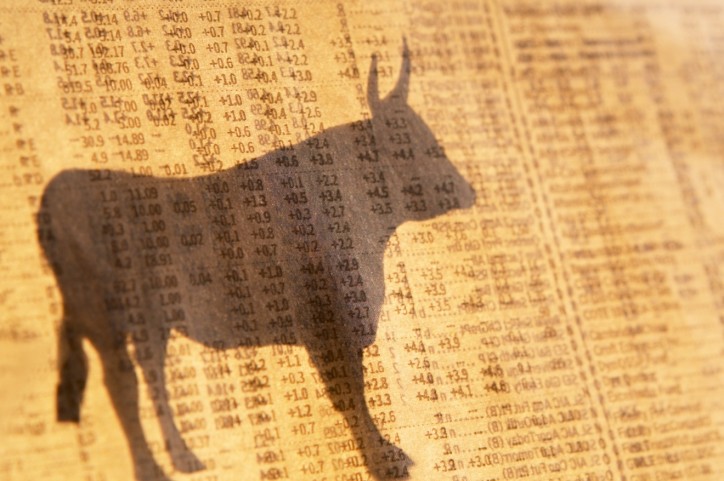by Niels Jensen, Absolute Return Partners LLP
What we’re seeing is a country [UK] that’s determined to commit economic suicide but can’t even agree on how to kill itself. It is an epic failure of political leadership
Thomas L. Friedman, New York Times
A brief recap of 2019
2019 was, in many ways, an outstanding year for equity investors but, towards the end of the year, something significant happened. When US companies reported Q3 earnings in October, investors punished companies that delivered growth at the expense of profits – something we haven’t seen for years. Companies like Twitter and Amazon, both of which delivered above-par revenue growth but below-par profit growth in Q3, were punished whilst a company like Tesla that did precisely the opposite was rewarded.
This change in investor behaviour was (and still is) particularly evident in the US shale industry. As 2019 progressed, rising output levels were no longer enough to satisfy investors who began to demand black numbers on the bottom line. And, as we all know, profits are not easy to generate when WTI trades in the $50s, whilst structural reasons ensure no profitability amongst (most) shale producers unless WTI trades in the $60s or higher.
Well, I wrote those lines before I went away for Christmas. After the dramatic worsening of the US-Iranian relationship in early January, WTI is now very much in the $60s. Going into an election year, considering how much of Trump’s campaign funding comes from Texas (see for example here), it is not beyond me to think that domestic issues also played a role when Trump decided that the Islamic Republic’s most celebrated military leader, Qassem Soleimani, should pay the ultimate price, but more about that later. Let’s go back to the recent change in US investor behaviour.
Credit markets behaved quite similar to equity markets last year. Following the US Congress’ decision to raise the debt ceiling on the 26th July, AAA-credit was suddenly in demand, whereas investors were net sellers of CCC-credit from August to December. Likewise the leveraged loan market which was under considerable pressure in late 2019 with issuance in Q4 down 40% year-on-year.
Risk #1: Liquidity conditions to tighten
The ensuing funding squeeze for lower-quality companies has had the effect of forcing these companies to run their business for cash. Suddenly, cash is king again and, if that trend were to continue into 2020, corporate debt levels, which have been on the rise in recent years, could begin to fall again.
That brings me to one of my major concerns, going into 2020. Let’s assume corporate debt levels don’t rise by 5% in 2020 (as they have done more recently) but instead fall by 5%. Such a reversal would take $2Tn of liquidity out of the US financial system – ten times more than the Fed can inject by cutting interest rates to zero (Source: MacroStrategy PartnershipLLP).
Such a tightening of liquidity conditions would almost certainly result in a recession, and here is why: Tightening liquidity conditions equal decelerating money supply growth which leads to reduced bank lending, i.e. slower velocity of money which affects GDP negatively.
Amongst US investors, it is widely perceived that, once the messy trade war between the US and China gets sorted, everything will be fine, but the liquidity issue I am raising here has nothing whatsoever to do with the trade war and everything to do with a change in investor behaviour and the ensuing change in corporate behaviour.
Risk #2: A declining capital stock
There are three types of capital stock:
1. Long duration capital stock - e.g. science and technology.
2. Medium duration capital stock - various competitive forces.
3. Short duration capital stock - mostly maintenance.
Remember that human capital is also part of the capital stock, meaning that changing demographics (a shrinking workforce) will also result in a decline of the (long duration) capital stock. Likewise political capital. As populism gains momentum (as it did in the 1930s, leading to World War II), political capital will decline, negatively affecting the (medium duration) capital stock.
Here is the problem: In the current cycle, the first two types of capital stock – long and medium duration – have both started to decline, meaning that the total capital stock is already in decline. The third – short duration capital stock – is holding up for now, leading many to falsely believe everything is hunky-dory, but it isn’t.
When medium and long duration capital stock are in decline, it is only a question of time before the painful truth will dawn on investors. The fact that capital owners are under-investing in new technologies will significantly – and very negatively – affect the long-term growth potential of the economy. It is akin to applying a plaster when major surgery is required.
A declining capital stock means that the economy becomes unable to support further growth and unable to support incomes at current levels. That creates underlying deflationary pressure. The only way to prevent an immediate chaotic clearing of the system is to cut interest rates to zero and to apply more QE. The problem with that solution is that, the lower interest rates are, the more capital is misallocated, i.e. deployed unproductively. Very low interest rates also lead to profound anomalies in valuations.
This has two implications. Firstly, on a tactical level, there are two (very) different outcomes. If substantial amounts of liquidity are injected, risk assets will most likely rise in price. If not, a deflationary bust will follow. Secondly, on a strategic level, if fiscal policy programmes, funded by QE, are introduced, we will probably end up with (much) higher inflation. My concern is that the political flavour of the moment seems to favour this model.
Risk #3: Normalisation of the Phillips curve
The Phillips curve is a measure of the link between the rate of unemployment and inflation. Actually, when the Phillips curve was first developed in the 1950s, it measured the link between unemployment and wage inflation but, gradually, the overall rate of inflation replaced the rate of wage inflation in the Phillips curve. From a practical point of view, as the two are highly correlated, it hasn’t made a massive difference. The link between unemployment and wage inflation is now referred to as the original Phillips curve or the wage Phillips curve.
One would expect (wage) inflation to be negatively correlated with the rate of unemployment and, back in my university days in the early 1980s when I first learned about the Phillips curve, that’s precisely how the two interacted. See Exhibit 1 below which is a model version of the original Phillips curve.

Source: Bank of England
The Phillips curve continued to behave as prescribed well into the 1990s but, towards the end of that decade, the curve began to flatten and has continued to do so ever since, i.e. the rate of unemployment has had less and less impact on the level of (wage) inflation. See Exhibit 2 which depicts the UK economy, but the picture is pretty much the same everywhere within the OECD.

Source: Bank of England
Now to my punchline: The original Phillips curve has begun to normalise! In other words, if wage inflation has risen more recently as a result of very robust employment conditions (as it has), could it be a matter of time only before the overall rate of inflation begins to rise?
In fact, I wouldn’t be at all surprised if central bankers around the world secretly wish for such an outcome. The debt supercycle we are currently in is about 75 years old – much older than the average debt supercycle – and I believe we are coming to the end of this one. When debt supercycles die, a period of debt destruction kicks in, and debt can only be destroyed in one of two ways – through default or inflation. There is no benign way out of debt supercycles.
Now, according to my sources in central bank circles, all central bankers would prefer for inflation to pick up rather than for defaults to rise. Should the Phillips curve therefore begin to steepen, do not be surprised if central bankers (deliberately) stay behind the curve and don’t raise rates as much as the theory books prescribe. That could effectively clear the system (a clearing which is long overdue), but it would probably create very difficult conditions for equity investors for a while.
Risk #4: Excessive optimism
To me, one of the best tactical indicators as to how equities will perform in the short to medium term would be various measures of excessive optimism/pessimism. When the level of optimism or pessimism reaches extreme levels, the equity market almost always does the opposite of what the uninitiated would expect. The logic behind is quite simple and is rooted in the fact that, when investors are exceedingly optimistic (pessimistic), most of their buying (selling) is already behind them.
Excessive levels of optimism/pessimism can be measured in different ways with one of my favourite sources of investor sentiment being SentimenTrader. As of a couple of weeks ago, 55% of SentimenTrader’s indicators showed extreme optimism – the highest number in the last 15 years. Precisely one year earlier, in late December 2018, 54% of the same sentiment indicators showed extreme levels of pessimism, and what happened? Equities had a phenomenal year (Exhibit 3).

Source: SentimenTrader

Source: SentimenTrader
Closely linked to the various measures of investor sentiment that I can think of is the average cash level amongst US equity mutual fund managers. The more optimistic they are, the less cash they typically hold and vice versa. With Mid-East tensions flaring at the moment, one could have hoped for cash levels to be higher than they currently are but, as of the latest count, only 2.8% is held in cash (Exhibit 4). By comparison, when the Gulf war broke out in 1990, US equity mutual fund managers held about 13% in cash.
Exhibit 4 above tells me that investors are, in general, ill-prepared for the rainy day that will show up on our doorstep sooner or later. I cannot promise you that it will most definitely happen in 2020 but the level of extreme optimism illustrated in Exhibit 3 suggests to me that the rain may actually arrive sooner rather than later, and I am sure the Aussies will raise the flag when that happens!
One final point re excessive optimism: The exceptionally robust performance of the S&P 500 last year – one of the very best performing equity markets in 2019 – was almost entirely due to P/E multiple expansion and had virtually nothing to do with EPS growth (Exhibit 5) – another sign that the optimists probably got a bit carried away as the bull market unfolded.

Source: WSJ (The Daily Shot), Bloomberg
Risk #5: US politics
In the US, we are now in election year, and that means plenty of unpredictable days ahead of us in the year to come. Before Christmas, I decided to zoom in on Elizabeth Warren and the risks she represents to financial markets. By saying that, I am not at all suggesting she would be a bad president for the average American – if anything, I think the opposite – but I think she would quickly become a liability for the average investor. Her planned inheritance tax will not be viewed kindly by US investors.
Then, over Christmas and New Year, President Trump decided to tell the Iranians what he really thought of them. As I write these lines, the Iranians have just retaliated by attacking some US army barracks in Iraq. How it will all pan out in the days and weeks to come remains to be seen. The Iranian attack looks, at least at first glance, as relatively superficial, so maybe the Americans will do nothing. I simply don’t know, but the entire situation is immensely delicate.
In Quartet, our associated private wealth management business (see here), we made many good decisions last year but none better than (a) our decision to establish a position in Russian equities and (b) another one in gold – views that were based on a mix of very attractive valuations in Russia, our bullish view on sweet oil prices and our conviction that investors were becoming too complacent. There were simply too many uncertainties knocking on the door not to hold any gold.
At year-end, we were up about 50% on our Russian equity position, when Trump suddenly decided to ruin my holiday. Although we are still up almost 50%, we are in the process of switching some of our Russian equity position into a direct commodity position exposed to oil, as it is impossible to quantify the risk to global equity markets, should the conflict between the US and Iran spiral out of control.
As I alluded to in the introduction, with the presidential election being only 11 months away, and with Trump likely to play more tactical games going into those elections, whether Qassem Soleimani deserved to die or not – and I don’t have enough intelligence to form an intelligent view on that question – I wouldn’t expect this to be the last bit of action from the Americans on this side of the elections.
Risk #6: Brexit, part II
I kindly ask you to read the opening quote from Thomas Friedman one more time – see page 1 again. That is precisely what the British have been up to the last 3 ½ years, and anyone who thinks differently is seriously deluded.
I am first and foremost a European. I believe in keeping Europe together – not because the EU is perfect (far from it) but because Europeans are actually quite tribal. Since the Viking roamed the British shores, there have been more than 500 armed conflicts somewhere in Europe, none more devastating than the two world wars last century. When the guns in Europe fell silent in 1945, a group of visionary European leaders gathered around a table and asked themselves the simple question – how do we ensure this never happens again?
The answer they came to was equally simple – increased integration. If people do business across borders, they make friendships and even marry across borders and are then much less likely to go to war against each other, the wise men said. Time has shown they couldn’t have been more correct. Apart from a few problems in Northern Ireland, in the Basque country and in one or two other countries, all of which were the result of domestic conflicts, Western Europe has been remarkably peaceful for the past 75 years, and the result is there for everybody to see. Nowhere in the world are living standards higher today. The British (or at least the English) are now doing their best to take all that apart again.
From an investment point-of-view, I expect the trade negotiations to cause plenty of hiccups in 2020. The divorce agreement is now in place, but trade negotiations haven’t even started yet. Those negotiations will likely lead to plenty of volatility in UK markets that investors can take advantage of. And those who argue that the EU has a vested interest in completing those negotiations ASAP as the EU has a significant trade surplus with the UK should ask for their school fees to be refunded. They clearly don’t understand one iota about economics.
Niels C. Jensen
8 January 2020
Copyright © Absolute Return Partners LLP














